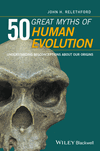HUMAN ORIGINS
Summary
The transition from an ape-like ancestor to human was not instantaneous or simultaneous. There is a long period of human evolution where some aspects of the human condition had evolved, but not others. This chapter examines some of the myths and misconceptions associated with the evolution of the apes and the emergence of early human ancestors. It concentrates on the evolutionary implications that some sort of ape evolved into an early form of human. Over time, evolutionary change will occur in this species due to the effect of natural selection and genetic drift on newly arising mutations. The formation of a new species is a function of the interplay of the four evolutionary forces described in an earlier myth: mutation, drift, selection, and gene flow. An important feature of bipedalism, increased brain size, and reduced canine size is that they are all traits that preserve in fossil remains.



